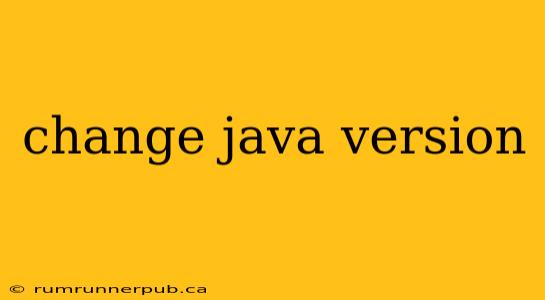Java's longevity means many developers work with multiple Java versions simultaneously – for legacy projects, new features, or specific library requirements. This article explores how to effectively manage and switch between Java versions, drawing from insightful answers found on Stack Overflow. We'll cover common scenarios and offer practical solutions beyond the basic commands.
Identifying Your Current Java Version
Before changing anything, you need to know what you're working with. The simplest way is using the command line:
java -version
This displays the Java Runtime Environment (JRE) version currently associated with your system's PATH environment variable. If you get an error, Java isn't properly configured in your environment.
Understanding the Output: The output typically looks like this:
java version "17.0.7" 2023-04-18 LTS
Java(TM) SE Runtime Environment (build 17.0.7+8-LTS-208)
Java HotSpot(TM) 64-Bit Server VM (build 17.0.7+8-LTS-208, mixed mode, sharing)
This shows the Java version, build date, and the JVM (Java Virtual Machine) details. Knowing this is crucial for troubleshooting compatibility issues later.
Managing Multiple Java Versions (JDKs)
Installing multiple Java Development Kits (JDKs) is a common practice. Instead of relying on only JAVA_HOME, utilizing a version manager like sdkman (or similar tools like jEnv) is highly recommended.
Why use a JDK manager? Managing Java versions manually using environment variables can quickly become cumbersome and error-prone, especially when dealing with multiple projects. A version manager streamlines the process, allowing you to:
- Install multiple JDKs: Easily install and manage different JDK versions side-by-side.
- Switch between JDKs: Seamlessly switch between JDK versions for different projects without modifying system-wide settings.
- Manage SDKs for other languages: Many version managers support other programming languages and SDKs beyond just Java.
(Example using sdkman - installation instructions vary depending on your OS, see the sdkman website)
- Install sdkman: Follow the instructions on the sdkman website.
- Install a JDK:
sdk install java <version>(e.g.,sdk install java 17.0.2). - List installed JDKs:
sdk list java - Use a specific JDK:
sdk use java <version>(e.g.,sdk use java 11.0.18).
(Addressing a common Stack Overflow question: How to switch between Java versions without breaking other applications): Using a version manager like sdkman elegantly solves this. Your system-wide Java installation remains unchanged, affecting only the current shell session where you've specified a JDK using sdk use. This prevents conflicts between projects using different Java versions.
Setting JAVA_HOME (Less recommended, but sometimes necessary)
While version managers are preferred, you might need to set JAVA_HOME directly in some situations (though generally avoid this for multiple JDKs). This environment variable points to the JDK installation directory.
- Locate your JDK: Find the directory containing your
binfolder (containingjava,javac, etc.). - Set JAVA_HOME: The method depends on your operating system:
- Linux/macOS: Edit your shell's configuration file (e.g.,
~/.bashrc,~/.zshrc) and add:export JAVA_HOME=/path/to/your/jdk - Windows: In System Properties (search for "environment variables"), add a new system variable named
JAVA_HOMEwith the path to your JDK.
- Linux/macOS: Edit your shell's configuration file (e.g.,
- Update PATH: Add
$JAVA_HOME/binto yourPATHenvironment variable (this is crucial for your system to find the Java executable).
Important Note: Always ensure your PATH environment variable points to the correct JDK version's bin directory after setting JAVA_HOME. Incorrect PATH settings are a frequent source of Java version issues.
Troubleshooting Common Issues
- Java not found: Verify your
JAVA_HOMEandPATHsettings. Double check for typos. - Multiple Java versions causing conflicts: Utilize a JDK manager to isolate projects using different Java versions.
- Incompatible libraries: Ensure your libraries are compatible with the selected Java version.
By following these steps and employing a JDK manager, you can effectively manage and switch between different Java versions, avoiding common pitfalls and ensuring a smooth development experience. Remember to consult the official documentation for your chosen JDK manager for the most accurate and up-to-date instructions.
